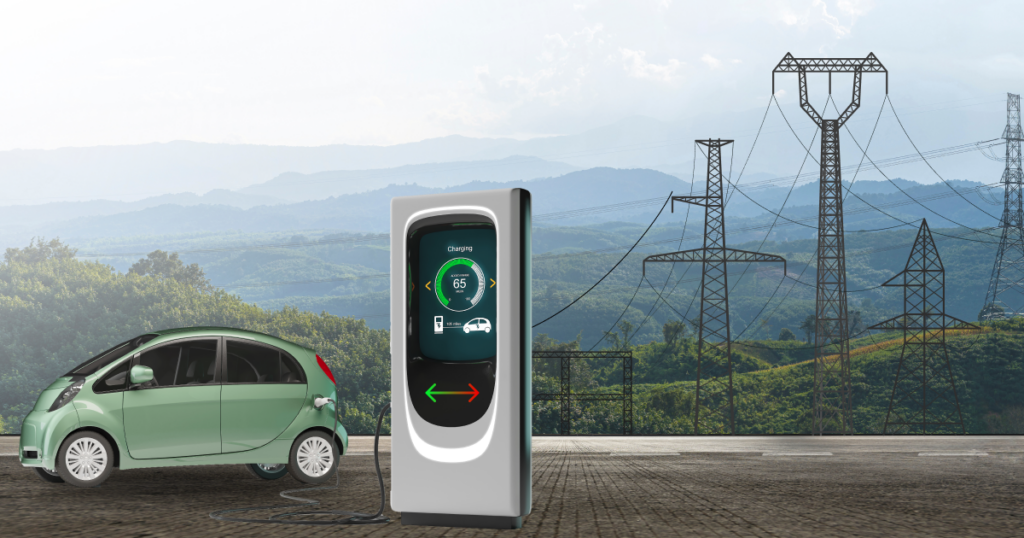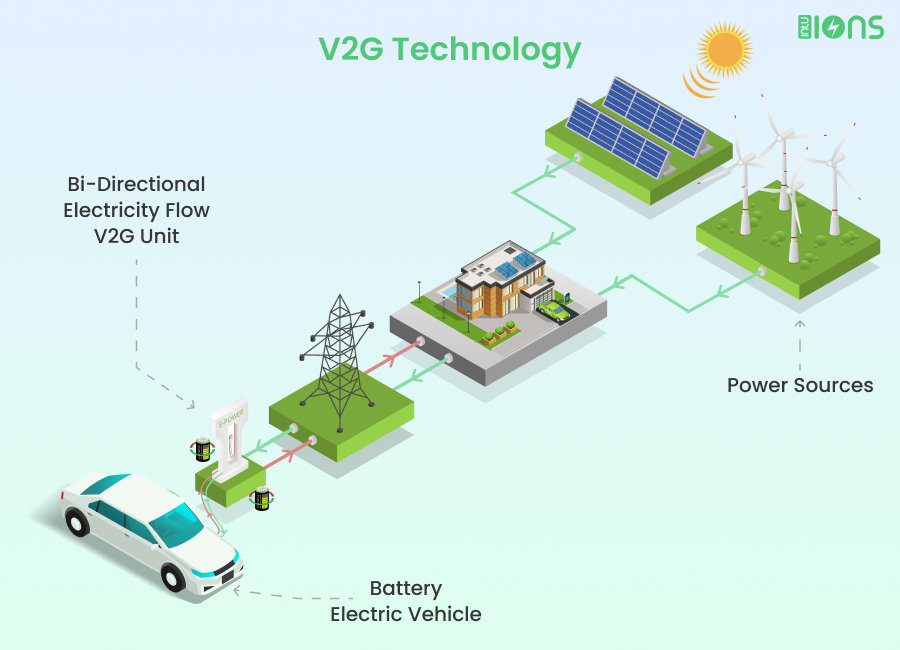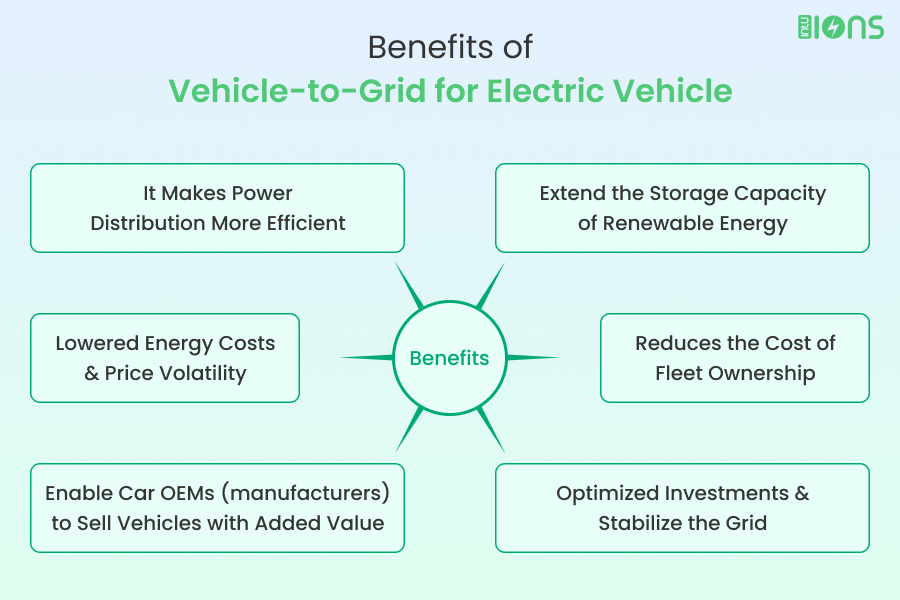Unlock the Full Potential of Your EVs With New-age V2G Technology

According to Statista, the global EV market is experiencing a sharp surge, with an estimated annual growth rate of 17.02% by 2027. The rise in EVs has several environmental benefits, but it could put a strain on the national power grid, thus making it unstable.
An average EV needs 30 kilowatts to drive 100 miles. It is the same amount of electricity used to power up a typical American household. Moreover, according to an estimate by the Department of Energy, the soaring number of plug-in EVs might increase the load on the electric grid by 38% by 2050.
Government agencies and electricity companies are working towards finding feasible solutions to meet the rising demand.
V2G for EVs: Powering the Future of Electric Vehicles and Beyond
As it is said, “modern problems require modern solutions” V2G for electric vehicles technology is a game-changer for the electric vehicle market. Before we dive deeper into the subject, let us see what is V2G technology.
The Future of EVs – Explore the Ground-Breaking V2G Technology
The automobile industry is experiencing rapid developments with emerging EV markets. One such revolutionary development is vehicle-to-grid technology which is becoming popular among OEMs and automakers.
Vehicle-to-grid or V2G is an innovative charging technology that enables the EV battery to generate, stock, and distribute the additional energy back to an electrical grid.
To put it in simple words: When an electric car is immobile, high-capacity batteries can be used to store and supply extra electricity back to the power grid. The purpose of vehicle-to-grid for electric vehicles is to optimize the grid’s operation when the demand peaks, like on a hot summer day when everyone is running their air conditioners.
Power on Wheels: This is How V2G for Electric Vehicles Work?
EV batteries have immense potential and it goes beyond their primary purpose of supplying power for mobility. V2G technology converts the EV battery into energy storage space and connects it to the general power grid through a bi-directional charger, known as a V2G charger.

Though the fundamental concept behind V2G charger may look straightforward, it requires a complex suite of technology for successful implementation. Equipping charging stations with sophisticated software is important to create seamless communication with the central grid to meet the overall demand.
Vehicle-to-Grid for Electric Vehicle Market – Present and Future Trends
A recent surge in the production and sales of EVs across the world is one of the significant factors that has contributed to the V2G for EVs market.
Moreover, there is a rise in the demand for fast or turbo-charging stations, which can give a boost to the V2G market.
Let us see some figures to understand the present and future trends of the V2G market:
- The global vehicle-to-grid for electrical vehicle market was 1.77 billion dollars in 2021 and is expected to see a CAGR of 21.4% by 2022 to 2031.
- According to Precedence Research, the market would grow to 17.43 billion dollars by the end of 2027.
Why is V2G Technology Critical to Sustainable Energy?
One of the biggest benefits of V2G is that it balances out the large gaps in electricity demand and supply, bringing down unnecessary infrastructural expenses.
Moreover, when there is a spike in power consumption, vehicle-to-grid can fill the gap between supply and demand, stabilizing the grid more stable minus an excess overhead cost. Furthermore, investing in vehicle-to-grid is more cost-effective and sustainable than continuously looking for newer energy sources.
A Step Towards Efficient Energy Management: Explore these Amazing Benefits of Vehicle-to-Grid for Electric Vehicles
Right from grid stabilization to lower carbon emissions, the benefits of vehicle-to-grid are innumerable. Here we have listed down some of the advantages of V2G for EVs:

- It Makes Power Distribution More Efficient
The real challenge for power companies is to meet the fluctuating demand for electricity throughout the day.
Most EV owners would plug in their vehicles at the same time when demand from households and commercial spaces is at its highest. Needless to say, this makes the grid more volatile, further causing power outages. V2G technology can allow power companies to expand their power generation and distribution capacity to meet the demand surge and alleviate the (extra) load on the grid system.
A study found that when 1 million EVs were introduced in the Guangzhou region in China without V2G infrastructure, the difference between peak and valley load time was reduced by 43%. However, when V2G technology was implemented, the difference increased up to 50%.
- Extend the Storage Capacity of Renewable Energy
Renewable sources such as wind and solar power play a key role in sustainable energy. However, these sources aren’t consistent as they depend on various atmospheric conditions. Therefore, for an efficient power grid, it is important to capture renewable electricity whenever it is available and store it for further distribution.
While the current systems can easily store renewable energy, a surge in power generation – for example during high winds – can max out the storage capacity. This means the chance to use this energy is wasted. V2G technology makes it possible to expand the storage capacity as the EV batteries can be used to stock the additional electricity.
- Lowered Energy Costs and Price Volatility
A lot of utility cost volatility boils down to demand and supply. The more pressure on the grid, the more it adds up to the overall expenditure. However, when the supply can meet the demand, it lowers energy costs and brings price stability.
For example, a study showed that a single V2G charger would create $600 in economic benefits for other utility ratepayers.
- Reduces the Cost of Fleet Ownership
Vehicle-to-Grid (V2G) technology enables electric vehicles (EVs) to sell excess energy stored in their batteries back to the grid. By using EVs as a source of energy depository, fleet owners can reduce their reliance on traditional electricity sources and lower costs. Additionally, the revenue generated from selling surplus energy can counterbalance the charging cost of EVs, further reducing the total expenditure of ownership. Overall, V2G technology offers a unique opportunity for fleet owners to optimize the use of their EVs and reduce the costs associated with energy storage and management.
5. Enable Car OEMs (manufacturers) to Sell Vehicles with Added Value
By offering V2G technology as a standard feature or optional upgrade in their EVs, car OEMs can differentiate themselves from competitors and offer their customers a unique value proposition. As the demand for EVs continues to grow, the ability to provide a vehicle that can also help manage energy costs and provide a valuable service to the grid will become increasingly important in the marketplace.
6. Optimized Investments and Stabilize the Grid
V2G-enabled EVs create new opportunities for vehicle owner to optimize their investment. For example, during periods of high demand, they can sell the reserved power back to the grid at a higher price, effectively making a profit. This not only helps the electric companies to optimize their energy balance but also enables the EV owners to generate new revenue streams.
The Cross-Industry Applications of V2G Technology for EVs
- How OEM can Benefit From V2G Technology?
Vehicle-to-Grid (V2G) technology brings a myriad of opportunities for automotive OEMs. Let us see some of the benefits:
- Today, the world is rapidly adopting sustainable energy systems. However, the road to green electricity is not an easy one. With V2G-enabled vehicles, OEMs can key a role in creating a reliable sustainable power source.
- V2G technology allows OEMs to be a part of the research, development, and deployment of EV charging and power storage infrastructure, further encouraging the growth of the EV market.
- Furthermore, V2G technology plays a crucial role in the development of smart cities. It allows OEMs to create sustainable and connected communities.
- How can V2G Technology Benefit Utility Providers?
To achieve a green and clean economy, it’s essential to decarbonize energy sources. However, replacing fossil fuels with renewable sources have its challenge. Renewable alternatives rely on several environmental factors, making them intermittent.
But, with the energy industry starting to incorporate more alternative sources, power storage becomes critical to stock the generated electricity. V2G technology provides a feasible solution for utility companies. With an increasing number of vehicle owners going electric, utility providers could reduce the manufacturing expense that comes with high-capacity batteries. Instead of this, they can leverage the plugged-in EVs for stocking the energy as they convert a large chunk of electricity production to renewable sources.
- V2G for Vehicle Owners – Benefits that Goes Beyond Mobility
EVs are plugged in – either at the home, workplace or in a parking lot – most of the time. Today, an electric vehicle can communicate with the charger displaying battery percentage and how rapidly the EV can accept the power. However, with technological advancement, V2G-enabled vehicles can easily transfer payment information at public charging stations. Moreover, it unlocks extra functionality by developing a secure gateway between the EV owner and OEM.
Further, EV owners can align the V2G hardware with various third-party applications facilitating super-fast data speeds. Also, V2G would allow consumers to ensure uninterrupted electricity supply to their homes via EV battery during power failure.
In addition to this, EV owners can leverage their vehicles’ battery capacity to sell electricity back to the grid during peak days.
Besides, users can decide a cap on how much power can be extracted to avoid the overuse of the battery. They could further personalize the settings and choose to buy back electricity when it is not expensive and sell to the grid only at high prices.
- V2G Technology – Reduce Bottlenecks for Power Grid
Renewable electricity sources are unstable, creating challenges for industries that depend on wind or solar power. Such grid bottlenecks are the major cause of power outages. However, there are smartly controlled EVs that offer a solution to grid congestion, preventing the need for expensive infrastructure upgrades.
How Implementing V2G Technology is Making a Difference?
V2G is relatively new and so it is important to have a look at various real-life projects from different parts of the world. Here are two projects that will throw insight into the practical use of this technology:
- Groupe Renault Trial Project – How V2G Technology is Changing the Future of Energy Management in Europe
Groupe Renault, in 2019, started working on a trial project where 2 ZEO V2G prototypes were added to an existing fleet of EVs. They realized that vehicle-to-grid systems can play a huge role in smart energy management.
Taking a step towards the future of reversible charging, Groupe Renault is planning to roll out 13 more ZEOs equipped with bi-directional V2G chargers at various places across Europe.
- Project Sciurus – Changing the Future of Sustainable Energy in the United Kingdom
As a part of the project, over 320 V2G charging points were installed across homes in the UK. The V2G units had an export power higher than the typical demand in a household. Thus, the excess power was sent back to the grid which was controlled by a central system that exported the energy to more electricity networks during peak hours.
Takeaway
V2G for EVs is a pathbreaking technology that will not help to make the grid more stable, but also reduce the overall carbon footprints by lowering the CO2 emissions.
V2G requires specialization and expertise for the seamless integration of a complex suite of technologies. If you are looking for someone who can take care of your V2G needs, call IntuIons. We have the right set of skills and knowledge to deliver outstanding results within a quick turnaround time.
